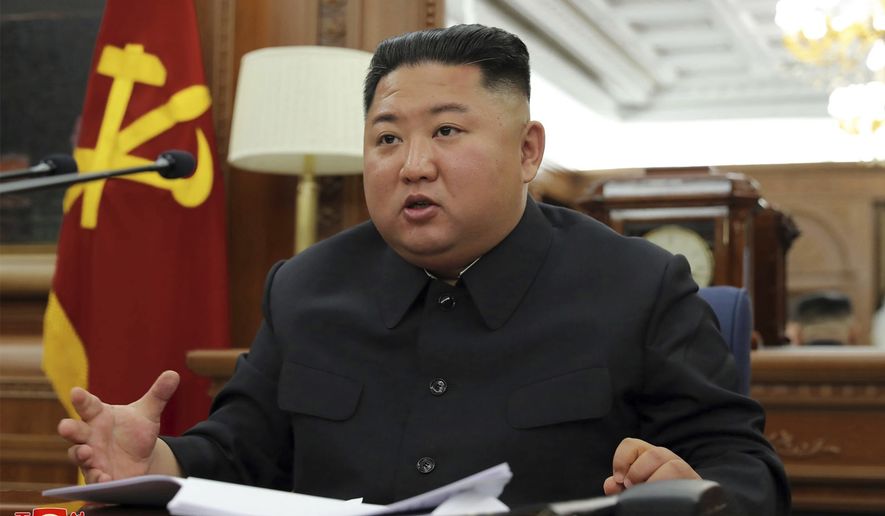The U.S. this week dramatically ramped up surveillance over North Korea ahead of Pyongyang’s anticipated “Christmas gift,” while the Pentagon sent an unmistakably blunt message by leaking news of a November special-operations drill that practiced taking out top North Korean officials.
The revelations underscore how seriously the Pentagon took North Korea’s threats, which was expected to be a long-range ballistic missile test or even the resumption of nuclear weapons testing.
Pyongyang hasn’t tested nuclear weapons since 2017, after which President Trump embarked on a path of unprecedented diplomatic outreach to leader Kim Jong-un, which has included three in-person meetings.
While Christmas came and went with no signs of any major North Korean tests, regional analysts say the U.S. military was wise to ramp up its surveillance. It’s unclear whether the public disclosure of such intelligence, surveillance and reconnaissance (ISR) — first reported by South Korea’s Yonhap News Agency — played a role in altering North Korea’s plans.
“It makes military sense to do so … I would have recommended an ISR surge to try to discern North Korea’s next move,” said David Maxwell, a senior fellow with the Foundation for Defense of Democracies who served extensively on the Korean Peninsula during his three decades in the Army.
Yonhap reported that four U.S. aircraft — an RC-135W Rivet Joint, an E-8C, an RQ-4 Global Hawk and an RC-135S Cobra Ball — flew over North Korea on Tuesday and Wednesday, just as Pyongyang was expected to deliver its Christmas surprise. The flights over the Korean Peninsula were also detailed by Aircraft Spots, a site that tracks the movement of military aircraft.
As the military carried out its surveillance flights, Mr. Trump publicly downplayed the expected North Korean test, even suggesting that Mr. Kim would be offering a more traditional Christmas gift.
“Maybe it’s a nice present. Maybe it’s a present where he sends me a beautiful vase, as opposed to a missile test, right?” Mr. Trump said Wednesday. “I may get a vase. I may get a nice present from him. You don’t know. You never know.”
Mr. Trump has made denuclearization efforts with North Korea a top foreign-policy priority. After initially warning in 2017 that North Korea would be met with “fire and fury” if it continued down the path toward nuclear weapons, the president has since toned down his rhetoric amid a diplomatic push.
The White House has pursued a denuclearization deal with North Korea that would see the country permanently and verifiably abandon its nuclear weapons program in exchange for the lifting of economic sanctions. The president has also promised a major wave of foreign economic investment into North Korea if it abandons its nuclear ambitions.
But the two nations have not been able to reach a final deal. North Korea has insisted that some economic sanctions be lifted before it commits to full denuclearization, while the U.S. has maintained that nuclear programs fully end before any financial relief is offered.
While the U.S. has continued to offer up diplomatic olive branches to Pyongyang — including the suspension last month of another round of U.S.-South Korean joint military drills — the Pentagon also routinely flexes its muscle on the peninsula.
Last month, U.S. and South Korean commandos reportedly conducted joint drills in which they rehearsed raids on enemy facilities and the capture of top enemy officials. The drills were first reported by Reuters earlier this week.
The exercises apparently took place in November, but Reuters reported Monday that it recently viewed photos of the drills, which were carried out at American military facilities in Gunsan, a city in the southwestern part of South Korea.
By letting media outlets view the photos and report on the drills so close to Christmas Day, the Pentagon sent a clear signal to North Korea that it continues to prepare for military action, including the potential targeting of officials in Mr. Kim’s inner circle.
Despite the lack of a Christmas surprise, there are still growing fears that Mr. Kim may again take a more aggressive stance that could include major weapons tests. Japan’s Kyodo News reported earlier this week that Mr. Kim has ordered the mass production of vehicles used for the transportation of ballistic missiles.
Foreign policy specialists say the Trump administration can and should continue diplomatic outreach but must also be prepared for Pyongyang to go down a more provocative path.
“Deterrence has worked for 65 years and, as Kim is not suicidal, it endures, though conflict by miscalculation remains a risk. But imminent missile, and possibly nuclear, tests will heighten tensions and war fears,” Robert A. Manning and Patrick O’Reilly, senior fellows at the Atlantic Council, wrote in a blog post this week.
• Guy Taylor can be reached at gtaylor@washingtontimes.com.
• Ben Wolfgang can be reached at bwolfgang@washingtontimes.com.




Please read our comment policy before commenting.